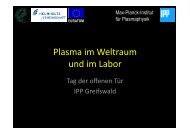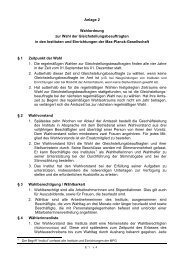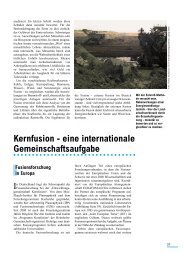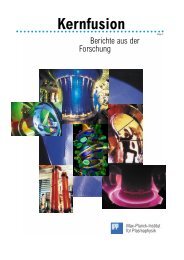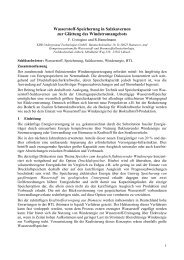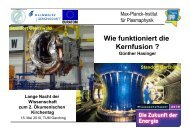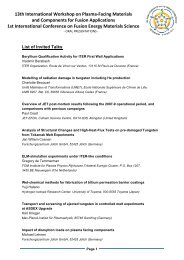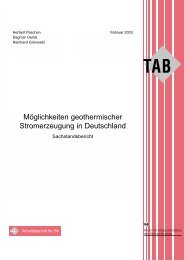IPP Annual Report 2007 - Max-Planck-Institut für Plasmaphysik ...
IPP Annual Report 2007 - Max-Planck-Institut für Plasmaphysik ...
IPP Annual Report 2007 - Max-Planck-Institut für Plasmaphysik ...
Create successful ePaper yourself
Turn your PDF publications into a flip-book with our unique Google optimized e-Paper software.
Most of the power transfer takes place at larger scales. For<br />
experimental conditions (C=1), the direction of power transfer<br />
of the density fluctuations has changed to the opposite<br />
direction and one can identify a local direct cascade at<br />
smaller scales, which is also expected for the enstrophy<br />
transfer. This cascade is also present in the potential fluctuations,<br />
but due to the weighting of the vorticity with k 2 it is<br />
much more pronounced in the enstrophy cascade. The simulation<br />
at the realistic value of C=1 agrees with the experimental<br />
result.<br />
Investigations of microwave material properties in a<br />
three-mirror resonator configuration<br />
For the construction of future fusion experiments like ITER<br />
and W7-X, where long-pulse, high-power ECR applications<br />
are planned, the definition of realistic cooling requirements<br />
of mm-wave components is crucial. To enlarge the data base<br />
on ohmic losses of reflectors due to finite conductivity,<br />
imperfections of the material, and especially surface modifications<br />
by long-term plasma exposition, various mirror samples<br />
have been investigated at 140 and 170 GHz using a<br />
three-mirror resonator. The losses depend on the position on<br />
the mirror, confirming strong influence of plasma on the invessel<br />
components. The absorption coefficients for 170 GHz,<br />
E-plane, 45° angle of incidence for a ASDEX Upgrade mirror<br />
are 0.36-0.44 % and for a W7-AS mirror 0.39-0.43 %.<br />
Additional measurements of the W7-AS mirror surface with<br />
a roughness detection instrument and spectroscopic analysis<br />
confirmed the strong influence of different surface deposits<br />
on mirrors, depending on the placement inside the torus.<br />
Measurements on non-exposed W7-X TZM mirrors yield<br />
comparable absorption with previous results for copper and<br />
aluminium surfaces, all significantly lower (0.21 %) than for<br />
the exposed samples.<br />
Optimization of smooth-wall HE 11 Horn antennas<br />
The existing waveguide codes were extended by a scattering<br />
matrix module, which allows the calculation of mode conversions<br />
due to diameter changes in cylindrical waveguides.<br />
In contrast to the faster coupled mode equation algorithm,<br />
the scattering matrix method does not neglect reflected<br />
waves and is not limited to slight diameter variations. Based<br />
on this, a program was developed, which optimizes the<br />
function r(z) (r: waveguide radius, z: axial coordinate) for<br />
given input- and output radii. Since mode conversion is<br />
highly dependent on the phase differences of coupled modes,<br />
the total length can also be changed by the optimizer. This<br />
code can be used to optimize any kind of mode converter<br />
with varying diameter. For a horn antenna, the wanted aperture<br />
field is expanded into a spectrum of complex mode<br />
amplitudes, which are then used as the optimization goal.<br />
University of Stuttgart<br />
116<br />
Figure 2 shows the measured far field of an optimized horn<br />
at 140 GHz in co- and cross polarization. The side-lobe level<br />
is very low the level of cross-polarization, however, is -17 dB,<br />
which is too high for some applications. The improvement<br />
of the codes for better results is an ongoing task.<br />
Figure 2: Far field of the horn antenna in co-polarization (left) and crosspolarization<br />
Materials with negative index of refraction<br />
The propagation of electromagnetic waves in waveguide<br />
structures with negative index of refraction has been investigated<br />
with a commercial full-wave solver (CST-Microwave<br />
Studio). Calculations and experiments on waveguides with<br />
different filling like thin wire structures, which exhibit behaviour<br />
similar to plasma (negative permittivity), and/or<br />
resonant structures like split rings (negative permeability)<br />
have been performed. Especially, experiments on TM 11 waveguides<br />
with wire structures confirmed the backward wave<br />
propagation at resonant frequency.<br />
For high-power applications in experimental plasma physics,<br />
feasibility studies on application of the principle of a negative<br />
refractive index, e.g. for backward-forward scanning<br />
leaky-wave antennas and other microwave components have<br />
been started. A design based on coaxial balanced CL-LC<br />
transmission lines is proposed. The optimization of the<br />
structures that allow high current-density handling, and<br />
numerical simulations using CST are underway. The excitation<br />
of backward waves based on coupled cavity chains was<br />
shown. The back-fire to end-fire scanning capability of this<br />
new metamaterial-based leaky-wave antenna for high power<br />
applications was numerically confirmed.<br />
Scientific Staff<br />
P. Brand, G. Birkenmeier, E. Holzhauer, H. Höhnle, A. Jooß,<br />
W. Kasparek, A. Köhn, H. Kumric, C. Lechte, N. Mahdizadeh,<br />
P. Manz, B. Nold, B. Plaum, K. Rahbarnia, M. Ramisch,<br />
L. Stollenwerk, U. Stroth.




